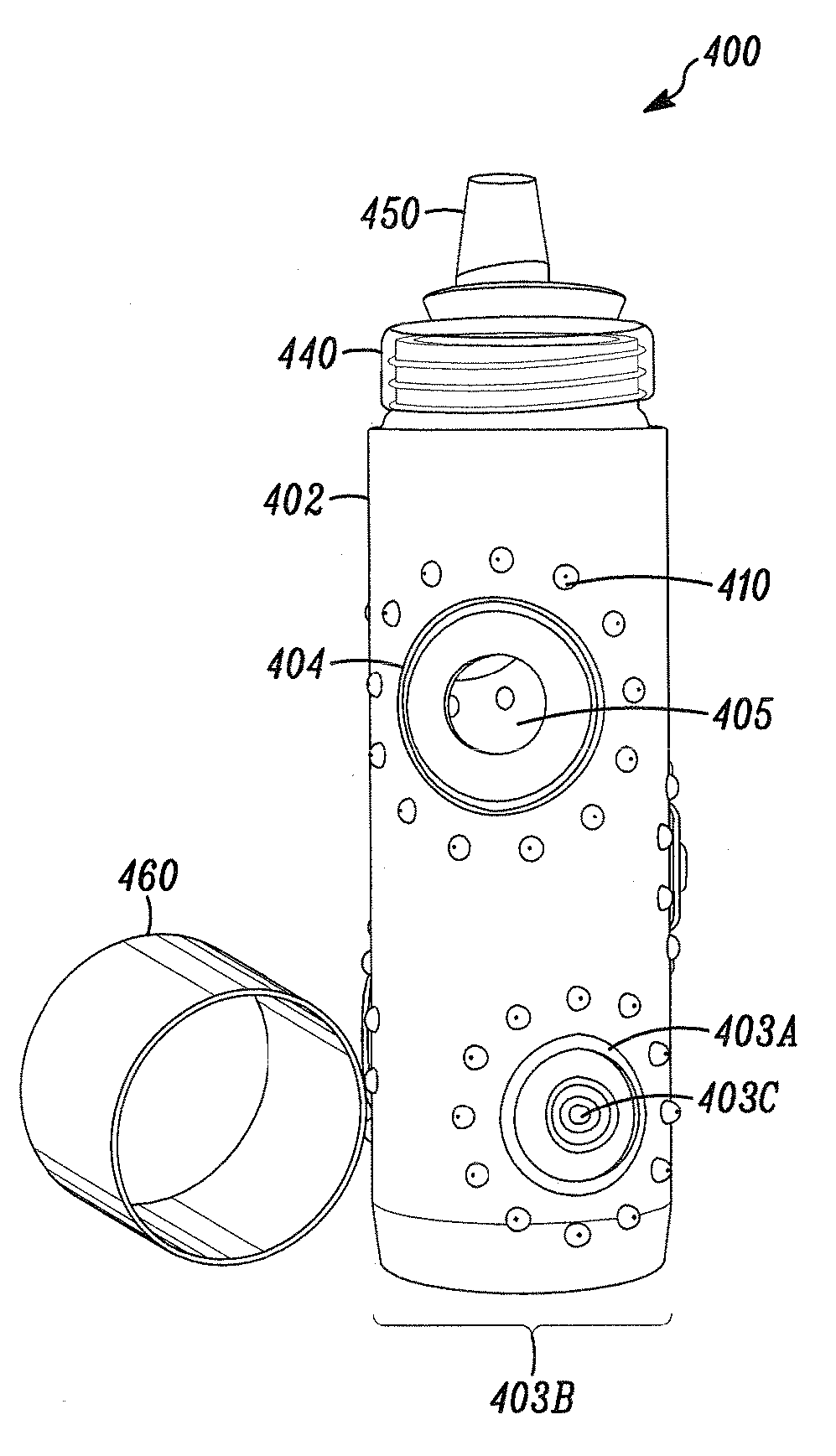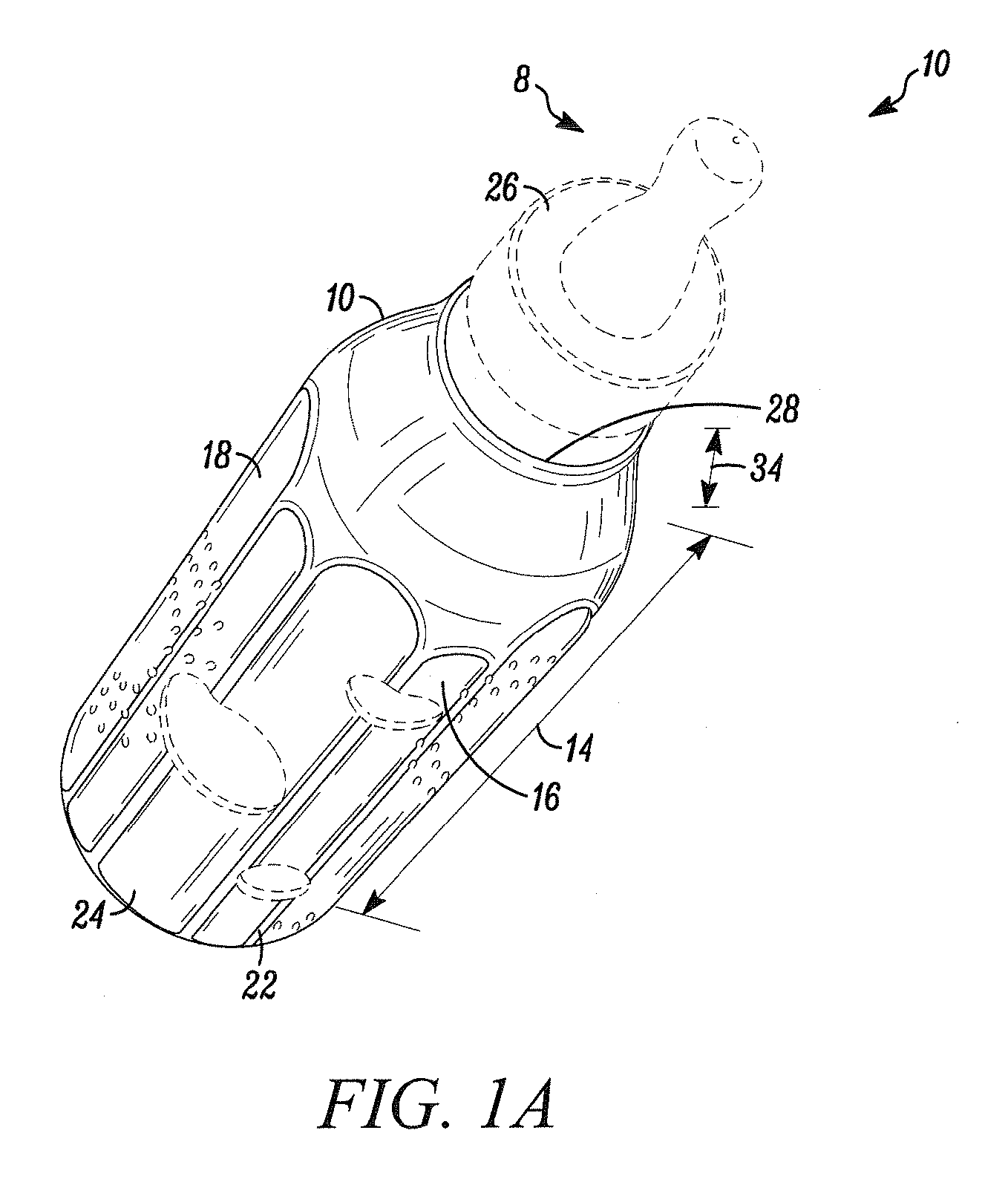Impact-resistant casing for breakable containers
a technology for breaking containers and casings, which is applied in the field of impact-resistant casings for breaking containers, can solve the problems of shortfalls in glass use, glass can break, and broken glass can be dangerous, so as to and reduce the frequency of breakage
- Summary
- Abstract
- Description
- Claims
- Application Information
AI Technical Summary
Benefits of technology
Problems solved by technology
Method used
Image
Examples
example 1
Production of a Silicone Structural Material
[0072]A silicone material can be preselected and purchased from any of a variety of manufacturers known to one of skill. The manufacturing method selected, however, affects the physical and chemical properties displayed by the silicone product. Its important to note that not all silicone rubbers are the same, and different grades can be selected for different applications of the teachings herein.
[0073]A typical silicone compound, for example, may have 5 to 12 ingredients in its formulation. Literally, you can add anything to silicone imaginable to achieve various results. The polymer itself can vary with regard to vinyl, methyl and phenyl percentages, plasticity or molecular weight, volatile content, and polymerization. In parts per hundred rubber (phr), a typical formulation may include a silicone base (100), fumed or precipitated silica (2-5), ground quartz or CaCO3 (25-100), pigment (0.5-2.0), heat stabilizers (0.8-2.0), peroxides (0.8-...
example 2
Break-Point of Systems with Empty Glass Bottles
[0077]A state-of-the-art casing, as shown in FIGS. 1A-1B, was applied to an 8 oz glass baby bottle to create a state-of-the-art system, and the break-point of the state-of-the-art system was determined. The state-of-the-art system was dropped on its base onto a concrete surface, and breakage occurred at a drop-height of 4 feet.
[0078]An impact-resistant casing taught herein, as shown in FIGS. 2A-2B, was applied to the same type of baby bottle to create an improved system, and the system was likewise dropped on its base onto the concrete surface with the following results shown in Table 1:
TABLE 1RESULTSDROP HEIGHTState-of-the-Art CasingImpact-Resistant Casing(ft)of FIG. 1of FIG. 24Bottles broke every timeNo bottles broke after 20drops10N / ANo bottles broke after 20dropsBottles began bouncing andspinning in air after impactat this height18N / ANo bottles broke after ??drops
[0079]As can be seen from the above data, the impact-resistant casing ...
example 3
Break-Point of Systems with Glass Bottles Containing a Fluid
[0080]Empty bottles will not carry as much force upon impact as a bottle containing a fluid, and real-world use of a bottle will include dropping a bottle containing a fluid. This example compares the breakage obtained using the state-of-the-art casing of Example 2 and the breakage obtained using the impact-resistant casing of Example 2 when using bottles containing a fluid.
[0081]The state-of-the-art casing was applied to an 8 oz baby bottle containing 4 oz water to create a state-of-the-art system containing a fluid, and the system was dropped 6 times—each time the glass bottle broke when dropped on its based on the concrete surface. The impact-resistant casing was applied to the same type of baby bottle containing 4 oz water to create an improved system containing a fluid, and the system was dropped 30 times at increasing heights onto the concrete surface with the following results as shown in Table 2:
TABLE 2RESULTSDROP H...
PUM
 Login to View More
Login to View More Abstract
Description
Claims
Application Information
 Login to View More
Login to View More - R&D
- Intellectual Property
- Life Sciences
- Materials
- Tech Scout
- Unparalleled Data Quality
- Higher Quality Content
- 60% Fewer Hallucinations
Browse by: Latest US Patents, China's latest patents, Technical Efficacy Thesaurus, Application Domain, Technology Topic, Popular Technical Reports.
© 2025 PatSnap. All rights reserved.Legal|Privacy policy|Modern Slavery Act Transparency Statement|Sitemap|About US| Contact US: help@patsnap.com



